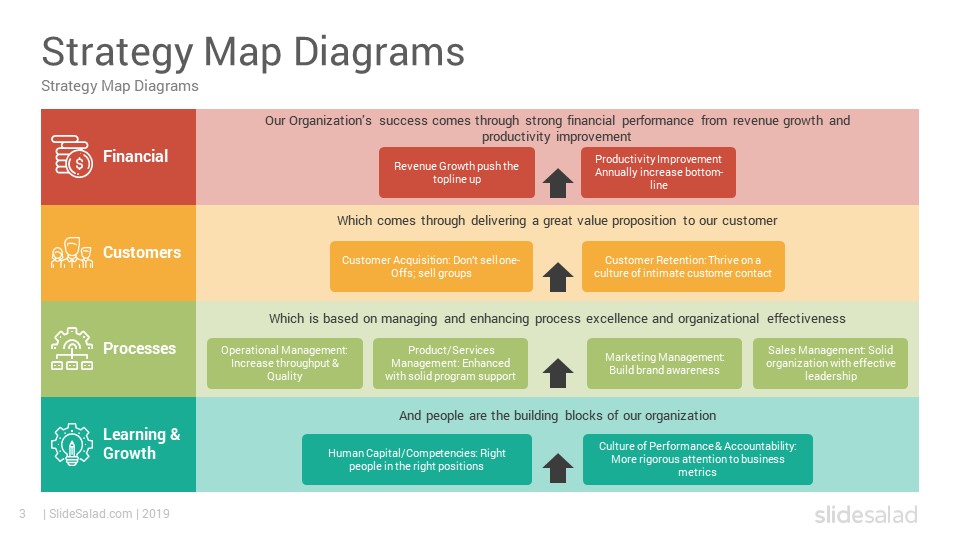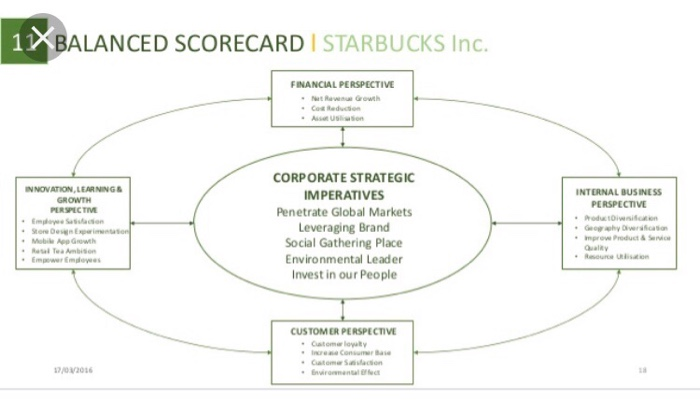- A Strategy Map is a diagram showing the causal relationships between strategic objectives according to the four perspectives (financial and customer perspectives, internal process, learning and growth). Strategy Maps are the cornerstones of the framework of the Balanced Scorecard project. They are the focal point of the system.
- The balanced scorecard adjusts that. It transcribes a common group of alternatives directly into a common strategy which is simple to understand. Strategy maps provide each employee a common goal to be aware of when attaining responsibilities and plans.
- The strategy map, which is used to visually display the strategy’s causally linked strategic objectives, and its subsequent companion balanced scorecard help answer a different question: “How will we get there?” Their purpose, together, is to successfully implement the strategy.
- How often should the strategy map be reviewed? Can we simply use the Balanced Scorecard or should we combine strategy maps and BSC?ˇ; What stages of strategy map design we need to pass in order to create a great strategy map; Play Example: Use Strategy Map for Visualization of Business Goals. Play Example: 2 Simple Rules About Strategy Maps.

To instantly download this presentation, enter your email address below. This Strategy Mapswith Balanced Scorecard deck is a 33-slide presentation available in Microsoft PowerPoint and Google Slides. Below you can read highlights of this collection.
Dec 31, 2012 - Explore Mike Richardson's board 'Balanced Scorecard & Strategy Maps', followed by 115 people on Pinterest. See more ideas about strategy map, strategies, strategic planning.
SYNOPSIS
90% of business strategies fail due to poor execution, according to Business 2 Community, which means effective strategy maps are especially important for the ultimate success of a business. With our Strategy Maps with Balanced Scorecard collection, you can document and hone in on your priorities, as well as visualize your organization’s plans implementation, so that all team players understand how to work together and know where they fit in.
SLIDE HIGHLIGHTS
To create greater long-term value for shareholders, the business must constantly work on improving its revenue growth and productivity. Use slides, such as this one, if you need a specific map for financial measures and drivers.
Bottlenecks and a lack of clarity hide opportunities for process improvement. Process mapping, on the other hand, helps to gain more visibility into operations. This slide lets you easily create and share process map with your team.
Take advantage of the Balanced Scorecard indicator dashboard. Note that the dashboard is adopted more to operations, so in it, the process starts with the determination of pertinent metrics and control of their value.
APPLICATION
Michael Gunther, the founder of Collaboration Business Consulting, suggests keeping in mind the following when mapping out your strategy:
Strategic plans don't solve problems – as natural problem solvers, leaders often subconsciously choose tactical strategies to find solutions. “There's a certain level of comfort in trying to solve problems versus determining what types of risk your company needs to take to achieve the next level of financial performance. Instead of focusing on solutions during strategic planning, focus on increasing the company's odds of success,” Gunther says.
Ensure the strategic plan is outward-focused – the main purpose strategic maps should serve is identifying the ways in which the venture wants to position itself in the market, taking in consideration the target customers’ needs and preferences.
Determine where your company exists – determine your target customer and market. When you have these two factors figured out, list strategies that will help you and your team to attract and retain those customers. Gunther says: “Include conversations on how to roll with an evolving marketplace, how to fill unmet needs of key stakeholders, which market dynamics will impact the company, and identify opportunities in the market for the company's products/services.”
Establish achievement goals – one important stop on your map should be creating a compelling value proposition for the target audience. This is when you should focus on setting clear goals, rather than creating tactics. Here, consider the drivers and barriers of acquiring new business, determine customer perception of your company versus its competitors, then establish a positional stance and decide which best practices can be employed.
Stay straightforward – strategic maps should be brief and precise. Keep your map to one page and include only the key choices that will be important for the company's revenue drivers.
Use clear logic – list the processes that your venture needs to change to achieve the main strategic goal. Add the information about the target audience, the industry's shifts, the competitive landscape analysis and your company's realistic capabilities. When your map is ready, move on to your implementation plan. “The implementation plan should answer the following questions […] What do we hope to accomplish and why? How will we plan to accomplish this task? How can we incorporate measurement tools to ensure the goal is achieved?” Gunther says.
CASE STUDY
Nike
Nike Inc. uses strategy maps to incorporate leadership responsibility into its day-to-day business practices. 'As we try to integrate corporate responsibility, it's really about systematic change in terms of how we do our contract manufacturing and the decisions that go into it,' Lee Weinstein, Nike’s spokesperson told Portland Business Journal.
As a part of the initiative, Nike implemented a balanced scorecard strategy approach, which means that contract manufacturers are being evaluated based on health and safety, as well as environmental and labor-management standards. Although Nike reviews its unique balanced scorecard criteria monthly, the company Director of Global Apparel and Corporate Responsibility, Mike McBreen, admits that the most challenging part of the process is establishing the performance measures. 'We are communicating the set of measures by which we hold ourselves accountable,' McBreen said. And in one of his corporate responsibility newsletters, McBreen wrote that business partners meeting Nike's goals will witness increased, higher-margin business and industry recognition for better performance.
What are Strategy Maps?
What are the pros and cons of the BSC approach?
Strategy Maps And Balanced Scorecards
A Strategy Map is a diagram showing the causal relationships between strategic objectives according to the four perspectives (financial and customer perspectives, internal process, learning and growth).
Strategy Maps are the cornerstones of the framework of the Balanced Scorecard project. They are the focal point of the system.
They help 'materializing' the passage from the expression of the strategy to the creation of value itself.
The establishment of Strategy Maps requires an in-depth work more than substantial.
Strategy Map And Balanced Scorecard Example
The quality of the management system is directly dependent on the adequacy and reasonableness of Strategy Maps.According to the authors, Robert S. Kaplan and David P. Norton, Strategy Maps are an indispensable tool to:
- Clarify the strategy and facilitate the communication of the said strategy to each employee
- Identify the key processes of successful strategic implementation
- 'Align' human, technological and organizational investments in order to work in the direction of the strategy
- Highlight the differences of implementation of the strategy, and thus facilitate the correction
Recommendations
- It is strongly recommended that the Strategy Map be held in a single page.
- Let's recall that the financial perspective is not necessarily expressed in the same unit of time than other components of performance. It is a more long-term loop and, in fact, the result of the three other perspectives.
- The success of strategic goals is directly dependent on men, culture and management, in short on the organizational quality. Remember that the success of strategic objectives is also strongly linked to the fluidity of information (IS).
- Even if the Strategy Map is a tool for expressing concrete strategy, it is also an instrument of information within the organization.
Strategy Maps book
Strategy MapsConverting Intangible Assets into Tangible Outcomes
Robert S. Kaplan and David P. Norton
Harvard Business School Press
The third volume of the Balanced Scorecard methodology
devoted to Strategy Maps
Additional resources
Share this...
| ©1998-2015 NODESWAY | Privacy | Legal |
